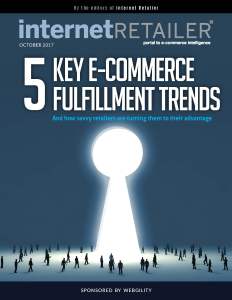
Better Insights Come From Seeing the Big Picture
Contents
 As published in Internet Retailer‘s 5 Key Ecommerce Fulfillment Trends
As published in Internet Retailer‘s 5 Key Ecommerce Fulfillment Trends
Mountain bike apparel retailer Club Ride recently faced a customer satisfaction challenge. The online company, which was founded in 2008, was growing rapidly, and earlier this year moved away from QuickBooks to more sophisticated tools to manage its fulfillment through its multiple sales channels. But without integration between sales, its e-commerce platform, its customers and its inventory, Club Ride often found itself unable to fulfill customers’ orders quickly—or even at all. As a result, its brand equity was suffering. Read how this apparel retailer adjusted their back-office workflows with Webgility's #Webgility Click To Tweet
Club Ride’s dilemma isn’t uncommon among retailers. Many merchants now sell through multiple sales channels—including online marketplaces, their own websites and their bricks-and-mortar locations—and must deliver orders to customers accurately and quickly to compete in today’s competitive retail arena. “While this adjustment increases the seller’s ability to scale, it also creates a new kind of chaos around data management and logistics when it comes to inventory, fulfillment, and shipping,” says Parag Mamnani, CEO of Webgility, an inventory management technology provider.
Adding to these challenges, Mamnani says free shipping and even free overnight shipping have become obligatory. “Whether built into the order price or not, consumers simply do not like to see shipping charges on their orders,” he says. “And because shipping costs are directly tied to profit margins, it is now essential that retailers have the ability to instantly compare fees of major carriers and have the freedom to choose which provider is best suited for each order.”
According to Mamnani, there is a way retailers can confront these challenges. “Retailers who take steps to view their multichannel business holistically stand the best chance at creating a sustainable and scalable retail model,” Mamnani says. “That holistic view is contingent on their ability to fully integrate all sales channels, business systems and software applications to work together.” From pick-and-pack to stocking to shipping software, Mamani says everything needs to be optimized to ensure profit margins can be maintained and even improved.
That’s exactly what Club Ride did to address its business challenges. The company implemented Webgility software, which enabled it to sync and track sales data, inventory, and customer information between its Shopify Plus site, Amazon, Square POS, and accounting in NetSuite*. The benefits were almost immediate. Since switching to Webgility, Club Ride now saves more than 50 hours per month on data entry. It has increased order volume by 20% and processes orders, including picking and packing, in one hour. And it now has accurate accounting, inventory, shipping data, and customer information.
“Webgility has offered an invaluable integration, and I think that we’re at a place where it’s going to get even better from here,” says Taggart Spenst, marketing and ecommerce sales manager at Club ride. “We’ve accomplished a lot in a year, and as sales continue to grow, it’s a momentum game. We’ve got a good foundation, now we’ve just got to keep building.”
According to Mamnani, with the right tools, any multichannel retailer can achieve success by gaining perspective on its entire business, and drilling down on details—such as workflow efficiencies, data entry expenses, marketplace fees, shipping costs and fulfillment expenditures—that have a big impact on the bottom line.
“Webgility automates data and workflows for multichannel businesses from all their systems—eliminating all manual data entry and subsequent errors,” he says. “In short, we give retailers the tools and technology they need to survive and compete.” Read more about how Club Ride scaled with Webgility.
*Indicates a legacy integration, no longer supported for new Webgility customers.
Yash Bodane is a Senior Product & Content Manager at Webgility, combining product execution and content strategy to help ecommerce teams scale with agility and clarity.



.png?width=56&height=56&name=image%20(1).png) Yash Bodane
Yash Bodane




